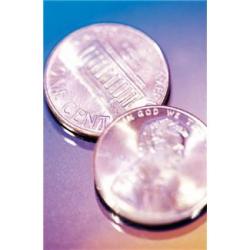Source Institutions
Source Institutions
Add to list Go to activity

In this chemistry activity, learners use chemical reactions to observe the composition of an alloy. Learners will calculate and record the amount (mass and percentage) of copper and zinc in a penny minted after 1982. Then learners will heat the penny to create a brass alloy. Use this activity to introduce learners to chemical reactions, alloys, and oxidation-reduction reactions. [Activity is publicly available through a web crawler capture on Archive.org.]
- Under 5 minutes
- 30 to 45 minutes
- $5 - $10 per group of students
- Ages 11 - 18
- Activity, Experiment/Lab Activity
- English
Quick Guide
Materials List (per group of students)
- Pennies minted after 1982
- 12M (concentrated) hydrochloric acid or muriatic acid
- 2 150 mL beakers or small jars
- 2 400 mL beakers or large jars
- 6 M NaOH solution
- elemental zinc, granulated
- metal shears
- hot plate
- evaporating dish
- tongs
Subjects
-
Engineering and Technology
-
Engineering
- Metallurgy and Materials Engineering
-
Engineering
-
Mathematics
-
Data Analysis and Probability
- Data Analysis
- Data Collection
-
Data Analysis and Probability
-
Physical Sciences
-
Chemistry
- Chemical Reactions
- Oxidation-Reduction Reactions
-
Structure and Properties of Matter
- Mass and Weight
-
Chemistry
-
The Nature of Science
-
The Scientific Process
- Conducting Investigations
- Gathering Data
- Formulating Explanations
- Communicating Results
-
The Scientific Process
Informal Categories
- Financial Literacy
Audience
To use this activity, learners need to:
- see
- see color
- read
- touch
Learning styles supported:
- Involves hands-on or lab activities
Other
This resource is part of:
Access Rights:
- Free access with registration
